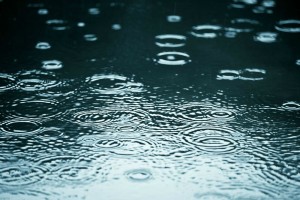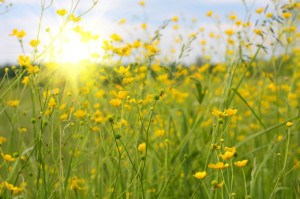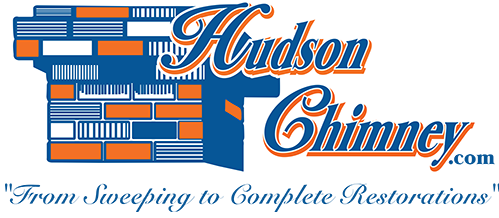by Mark Hudson | Mar 27, 2015 | Chimney Water Damage
If your home has a masonry fireplace, you might know that the Chimney Institute of America (CSIA) has named water as the biggest enemy of your chimney. Water penetration of your chimney is the biggest cause of expensive and extensive damage to the interior and the exterior of your home. Keeping water out of your chimney is the essential key to prevent the deterioration of the entire structure. At Hudson Chimney, our CSIA-certified technicians are well aware of the damage water can do to a masonry chimney, and we can find the leak, repair the damage, and then prevent further water penetration of your chimney. Often asked by our customers how water can be such a big problem, we would like to share three ways water leaks can do lots of damage to a masonry chimney.

1. Water leaks can cause brick and mortar spalling, which can lead to structural damage.
The exterior bricks and mortar of your chimney suffer a great deal of water exposure, and this water will penetrate into the materials, which causes them to erode. When this trapped water freezes inside your bricks and mortar, the breaking apart, cracking, and loss of masonry materials occurs when the temperatures rise and the water thaws. The expansion of the thawed water can be too much for bricks to endure, which is why they become loose and/or break off of your chimney. This phenomenon is known as spalling, and unrepaired spalling can lead to possible severe structural damage of your chimney. Additionally, water will continue to invade your chimney through the holes provided by the spalled bricks and mortar. If you ever notice loose bricks or mortar on the exterior of your chimney, contact Hudson Chimney for a chimney inspection. We will repair the damage and waterproof your chimney to prevent spalling from occurring again.
2. Water leaks can cause cracks and other deteriorations to your chimney flue liner, which can lead to carbon monoxide poisoning.
Water penetration not only affects the bricks and mortar of your chimney, but it causes damage to your interior flue liner as well. If you have a clay chimney liner, cracks will form due to water leaks, and if you have a metal chimney liner, rusting will occur from water exposure. Both of these problems can cause your liner to break apart and crack. A cracked liner can be a health hazard since your chimney liner serves to protect you and your family from the by-products of combustion, like toxic smoke and carbon monoxide, from entering your home. At Hudson Chimney, we can repair and restore clay chimney liners with HeatShield, and we can replace damaged liners with a durable stainless steel.
3. Water leaks can cause interior damage to your home, including stained walls and ceilings and mold growth.
Not only does water penetration of a masonry chimney cause many issues to the chimney itself, but a leaky chimney can also stain the ceilings and walls of the room where your fireplace is located. If you find water leak stains in your fireplace room, you should also consider the possibility of mold growth in the ceilings, walls, fireplace, and chimney. Contact Hudson Chimney as soon as possible if you ever see this sort of water penetration damage.
If you have more questions on what types of damage water penetration can do to a masonry chimney, contact Hudson Chimney today. We are happy to help you repair and prevent this kind of damage to your fireplace and chimney.
by Mark Hudson | Jun 10, 2014 | chimney maintenance

Leaky chimney got you down? Give the pros at Hudson Chimney a call!
Hudson Chimney has been giving quality chimney services for over thirty years now. And throughout our experience, we’ve collected a considerably wide knowledge when it comes to chimney problems and issues.
One of the most common issues that we’ve encountered throughout our experience is the case of the leaky chimney. Seven out of ten households with chimneys have been complaining about leaks and are asking for help to resolve said issue.
Here are a few things that you may find informative and rather helpful.
The common causes of chimney leaks:
- Although chimneys are generally concrete, there are cases wherein only the outside is solid and the inner portion is filled with solid fillers. According to the Chimney Safety Institute of America, majority of the masonry materials utilized are actually porous and are prone to absorbing water. The process of filling the brick plus the nature of the materials used makes the brick more susceptible to having cracks and channels that may serve as an entrance for water. One cracked brick is relatively harmless. But imagine fifty bricks or more? The amount of water that can pass through that is enough to cause an annoying leak around your house.
- For aesthetic purposes, many people make use of fashionable bricks in their chimneys. These bricks are more porous and rough on the surface compared to its regular counterpart. The key thing to look out for when using fashionable bricks is its flashing. The most preferred and advisable flashing to utilize is either the lead, lead coated copper or the copper (gold).
- Chimney flashing is done to prevent leakage. But sometimes when flashing is improperly installed, worn, inadequate or even corroded, this would backfire and cause what it’s meant to prevent in the first place.
Warning signs that your chimney is leaking:
- When you hear a constant, omnipresent dripping noise.
- Cracks and deterioration in the flue lining
- Water stains on or around your chimney
What you can do to fix it!
Your first instinct once you suspect your chimney is leaking is to go up there and see for yourself if there’s anything amiss. Although this is relatively the first thing you can do, it’s not as practical and effective as you may think. 80% of the time, people without training won’t be able to detect a leaky chimney or know how to remedy it. The quick and effective solution? Call our professionals and schedule an appointment as soon as possible so we can have your chimney waterproofed as well as install a chimney cap or crown!
by Mark Hudson | Mar 25, 2014 | chimney maintenance
Think of your chimney flue sort of like a drinking straw — its job is to pull what’s inside of it up, and out. And just like a straw, imperfections can quickly stop it from doing that job. Ever struggled with a straw that had a crack in it? A chimney with a damaged flue liner behaves in a similar way — the chimney’s draft can pull and pull, but cracks and gaps fight against the upward draw.

Your chimney should be free of any kind of blockage — otherwise you’ll have big problems to deal with. See to it that you have your chimney inspected and swept as scheduled.
If you’ve ever had a way-too-thick milkshake, you know how your flue responds to a blockage. Once again, try as it might, draft can’t pull the air and gases inside your chimney up, because something’s closing off the passage and hampering upward movement.
Blockages are a serious issue — depending on what it is that’s blocking your flue, you could end up with anything from a smoky living room to a fire hazard or toxic carbon monoxide leaking into your home.
During your annual chimney inspection, Hudson Chimney technicians always check your flue for blockages or potential blockages. But between inspections, if you’re noticing draft issues — from smoke to fireplace stains — give us a call. We can check to see if your flue is blocked, and make the necessary repairs to have your chimney properly venting again.
Some Of The Most Common Chimney Blockages:
Every situation is different, but there are certain types of blockages that we routinely come across at Hudson Chimney:
Nesting Animals Brought Flammable Debris Into Your Flue
Why It Happened: In most cases, animals move into your chimney a) because it’s an attractive place to nest and b) because nothing was stopping them from doing so. If your chimney isn’t closed off to birds and other visitors, they take that as a vacancy sign, and move right in. Their nests and other debris can quickly block your flue and affect your draft, and since nesting materials are generally flammable, they can also create a fire hazard.
What Hudson Chimney Can Do: install a quality chimney cap. Chimney caps help keep moisture out of your chimney, but they also lock animals, and their nests, out. If you want or need something special, we also install custom chimney caps!
Creosote Buildup Is Closing Off Your Flue
Why It Happened: Creosote buildup is a natural part of using a wood-burning heating appliance. Heated air, gases and particles produced through the combustion of wood rise up in the flue, then condense into a liquid as they reach the cooler flue walls. That condensation layers over time and with use, and you have creosote buildup. The longer you go without a professional chimney sweeping, the more creosote buildup you have — and it can get considerable enough to block your flue and affect your draft.
What Hudson Chimney Can Do: properly sweep your chimney, and help you develop a regular chimney sweeping schedule that keeps your flue clear and venting the way it should.
Damaged Flue Liner Pieces Have Fallen Into Your Flue
Why It Happened: Many older chimneys have flue liners made out of terra cotta clay tiles. Although those tiles can be pretty durable, it’s not uncommon for cracks to develop. If those cracks widen enough for pieces of tile to break off, they can fall into the flue and create a blockage. Cracked flue liner tiles are among the things Hudson Chimney technicians look for during a chimney inspection — and that’s an important part of what we do, because a damaged flue liner affects not only your draft, but your chimney’s ability to protect nearby combustible building materials from high heat.
What Hudson Chimney Can Do: assess the damage in your chimney liner, remove the blockage and bring your liner back to proper working order. That can include repairing your existing liner using HeatShield products or installing a new flue liner, depending on the state of your liner and your chimney.
Whether you’re having trouble with your chimney or just want to stay on top of regular maintenance to keep trouble away, Hudson Chimney is here to help. If you have any questions, or would like to make an appointment with our CSIA-certified technicians, give us a call!
by Mark Hudson | Mar 12, 2014 | chimney maintenance

It’s easy to forget about your chimney the moment spring comes to life. But you shouldn’t. Spring is the best time to give proper care to your chimney.
No matter how hard you try, you always seem to forget something when you are making your to do list for the upcoming spring season. You want to make sure you clean the house from top to bottom, begin the gardening, and plan for the summer vacation. Nowhere in this list, does taking care of your chimney’s maintenance fit in. This maintenance must be done and in a timely fashion to protect your family and your home’s safety. Call Hudson Chimney today to schedule your appointment.
Do you really need more than one chimney sweep?
It depends on your usage. If you are frequently using your fireplace, you may need two sweeps. This is because with an increase in burning, more creosote will be released. One chimney sweep should be done closer to burning season so that there is little time for anything to build up inside of the unit. The second should be done right after burning season to remove everything from the winter. You should always make sure your chimney sweep is Chimney Safety Institute of America (CSIA) certified. Since the spring season is also slower for chimney companies, you may be able to get a discount.
What are some common repairs that will need to be done?
Since winter storms can often time hurt your chimney’s structure, the spring season is when the repairs will usually begin. This is the time when weather warms up, but the wet season hasn’t kicked in. Your technician will know to check both the flashing and the rain caps.
You will also want to make sure that your chimney is sealed properly. After the unit freezes and thaws multiple times it will begin to crack and the caulk will begin to loosen. After the sweep and repairs, you should look into having the chimney waterproofed, especially if you live in a wet environment.
What do you do with the animals that may have gotten in your chimney?
Even though your first instincts are to panic, you should remain calm and give us a call. To keep both you and the animal safe, this should only be done by a professional. Animals will use your chimney for both nesting and storage, so having the required sweeps will remove all of their droppings. We also have experience removing carcasses. We’ll make sure there is nothing blocking your chimney.




